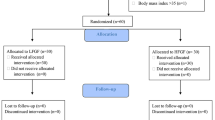Abstract
Purpose
Sevoflurane, with a relative low blood-gas partition coefficient, is an ideal anesthetic to achieve rapid offset and recovery from general anesthesia. This study will determine the profiles of four concentration–time curves to characterize the pharmacokinetics of sevoflurane elimination.
Methods
Eight patients (aged 54–76 years) undergoing coronary arterial bypass grafting surgery were enrolled in this study. At the end of surgery, anesthetic gas and blood were sampled 20 min before and after stopping sevoflurane administration, with prior maintenance of a fixed 5 % inspired sevoflurane (CIsev) in 6 L/min oxygen flow for 60 min before the cessation of sevoflurane administration for the subsequent 20 min elimination. An infrared analyzer was used to determine both CIsev and end-tidal sevoflurane (CEsev). The sevoflurane concentrations in the internal jugular-bulb (Jsev), arterial (Asev) and pulmonary arterial blood (PAsev) were analyzed by gas chromatography, and cardiac output was measured using an Opti-Q pulmonary artery catheter.
Results
A bi-exponential decay function was the best fit for the CEsev,Jsev, Asev, and PAsev time curves. There were two distinct components, the initial 5-min fast or distribution phase and the subsequent 15-min slow or elimination phase. Before cessation of the sevoflurane supplement, the step-down concentration of sevoflurane was listed in the following order: CIsev > CEsev > Asev ≧ Jsev > PAsev. During the elimination phase, the fastest decay occurred in CEsev, followed by Jsev, Asev and PAsev. Therefore, a reverse step-down pattern was observed (PAsev > Asev ≧ Jsev > CEsev) after 20 min. The ratio of Asev to CEsev was 89 % at baseline before stopping sevoflurane administration, but the ratio of Asev to CEsev increased to 128 % at the twentieth min of the sevoflurane elimination phase.
Conclusions
During elimination, the initial washout of sevoflurane from the functional residual capacity of the lungs was reflected in the fast component of the CEsev, Jsev, Asev, and PAsev time curves. In contrast, the slow component was dominated by the tangible effects of the physiological membrane barriers, such as the alveoli-pulmonary capillary and blood–brain barriers.


Similar content being viewed by others
References
Lockhart SH, Yasuda N, Peterson N, Laster M, Taheri S, Weiskopf RB, Eger EI 2nd. Comparison of percutaneous losses of sevoflurane and isoflurane in humans. Anesth Analg. 1991;72(2):212–5.
Yasuda N, Lockhart SH, Eger EI 2nd, Weiskopf RB, Liu J, Laster M, Taheri S, Peterson NA. Comparison of kinetics of sevoflurane and isoflurane in humans. Anesth Analg. 1991;72(3):316–24.
McKay ID, Voss LJ, Sleigh JW, Barnard JP, Johannsen EK. Pharmacokinetic-pharmacodynamic modeling the hypnotic effect of sevoflurane using the spectral entropy of the electroencephalogram. Anesth Analg. 2006;102(1):91–7.
Landais A, Saint-Maurice C, Hamza J, Robichon J, McGee K. Sevoflurane elimination kinetics in children. Paediatr Anaesth. 1995;5(5):297–301.
Wiesner G, Schwurzer S, Horauf K, Hobbhahn J. Emergence times, hemodynamics and adverse effects of sevoflurane and isoflurane: an open, randomized, comparative phase iii study. Anaesthesist. 1994;43(9):587–93.
Katoh T, Suguro Y, Kimura T, Ikeda K. Cerebral awakening concentration of sevoflurane and isoflurane predicted during slow and fast alveolar washout. Anesth Analg. 1993;77(5):1012–7.
Lu CC, Tsai CS, Ho ST, Chen WY, Wong CS, Wang JJ, Hu OY, Lin CY. Pharmacokinetics of sevoflurane uptake into the brain and body. Anaesthesia. 2003;58(10):951–6.
Nakamura M, Sanjo Y, Ikeda K. Predicted sevoflurane partial pressure in the brain with an uptake and distribution model comparison with the measured value in internal jugular vein blood. J Clin Monit Comput. 1999;15(5):299–305.
Lu CC, Tsai CS, Ho ST, Chueng CM, Wang JJ, Wong CS, Chang SY, Lin CY. Pharmacokinetics of desflurane uptake into the brain and body. Anaesthesia. 2004;59(3):216–21.
Lu CC, Lin TC, Hsu CH, Yu MH, Ku CH, Chen TL, Chen RM, Ho ST. Hyperventilation accelerates rise in arterial blood concentrations of sevoflurane in gynecologic patients. J Anesth. 2012;27:35–42.
Yamaoka K, Nakagawa T, Uno T. Application of Akaike’s information criterion (AIC) in the evaluation of linear pharmacokinetic equations. J Pharmacokinet Biopharm. 1978;6(2):165–75.
Behne M, Wilke HJ, Harder S. Clinical pharmacokinetics of sevoflurane. Clin Pharmacokinet. 1999;36(1):13–26.
Yasuda N, Targ AG, Eger EI 2nd. Solubility of I-653, sevoflurane, isoflurane, and halothane in human tissues. Anesth Analg. 1989;69(3):370–3.
Lu CC, Tsai CS, Hu OY, Chen RM, Chen TL, Ho ST. Pharmacokinetics of isoflurane in human blood. Pharmacology. 2008;81(4):344–9.
Lu CC, Tsai CS, Hu OY, Chen RM, Chen TL, Ho ST, Gan TJ. Pharmacokinetics of desflurane elimination from respiratory gas and blood during the 20 minutes after cardiac surgery. J Formos Med Assoc Taiwan yi zhi. 2013;112(4):185–92.
Acknowledgments
We wish to thank Professor Chung-Yuan Lin for his conceptual guidance on anesthetics elimination, as well as to appreciate Miss Yi-Fong Roa and Dr Cheng-Huei Hsiong for their technical and statistical support. This work was done in the Tri-Service General Hospital/National Defense Medical Center, Taipei, Taiwan. The grants are from both the National Science Council, 95-2314-B-016-003 and the C Y Foundation for Advancement of Education, Sciences, and Medicine.
Author information
Authors and Affiliations
Corresponding author
About this article
Cite this article
Lu, CC., Tso-Chou, L., Hsu, CH. et al. Pharmacokinetics of sevoflurane elimination from respiratory gas and blood after coronary artery bypass grafting surgery. J Anesth 28, 873–879 (2014). https://doi.org/10.1007/s00540-014-1841-7
Received:
Accepted:
Published:
Issue Date:
DOI: https://doi.org/10.1007/s00540-014-1841-7




